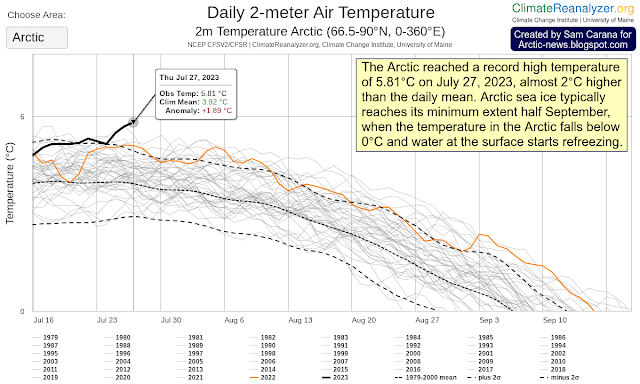Record high North Atlantic sea surface temperature
On July 25, 2023, the North Atlantic sea surface reached a record high temperature of 24.9°C. The previous record was in early September 2022, when the temperature peaked at 24.89°C, according to NOAA scientist Xungang Yin and as illustrated by the image below.
In previous years, a La Niña was suppressing temperatures, whereas El Niño is now pushing up temperatures. Arctic sea ice typically reaches its minimum extent about half September. We are facing huge sea ice loss over the coming weeks.
Temperatures are very high (and rising) and the following eight points contribute to this rise:
1. Emissions are high and greenhouse gas levels keep rising, and this is increasing Earth’s Energy Imbalance. Oceans take up 89% of the extra heat.
2. El Niño is pushing up temperatures, whereas in previous years La Niña was suppressing temperatures. Moving from the bottom of a La Niña to the peak of a strong El Niño could make a difference of more than half a degree Celsius, as discussed in an earlier post.
In February 2016, when there was a strong El Niño, the temperature on land was 3.28°C (5.904°F) hotter than 1880-1896, and 3.68°C (6.624°F) hotter than February 1880 on land. Note that 1880-1896 is not pre-industrial, the difference will be even larger when using a genuinely pre-industrial base.
The above image, from an earlier post discussing extreme heat stress, adds a poignant punchline: Looking at global averages over long periods is a diversion, peak temperature rise is the killer!
3. Sunspots in June 2023 were more than twice as high in number as predicted, as illustrated by the image on the right, from an earlier post and adapted from NOAA.
If this trend continues, the rise in sunspots forcing from May 2020 to July 2025 may well make a global temperature difference of more than 0.25°C, a recent analysis found.
4. A submarine volcano eruption near Tonga in January 2022 did add a huge amount of water vapor to the atmosphere, as discussed in an earlier post and also at facebook.
Deformation of the Jet Stream can also lead to stronger heatwaves on land that extend over the Arctic Ocean, which in turn can also strongly heat up the water of rivers that end in the Arctic Ocean. The image on the right shows huge amounts of heat surrounding Arctic sea ice and also shows that on July 28, 2023, the sea surface was as much as 19.7°C or 35.4°F hotter than 1981-2011 at an area where the Ob River meets the Kara Sea (green circle).
7. AMOC (the Atlantic meridional overturning circulation) is slowing down, further contributing to more hot water accumulating in the North Atlantic. Instead of reaching the Arctic Ocean gradually, a huge part of this heat that is now accumulating in the
North Atlantic may abruptly be pushed into the Arctic Ocean by strong storms that gain strength as the Jet Stream gets increasingly deformed. This danger grows as more ocean heat is accumulating in the North Atlantic and this situation threatens to cause huge eruptions of methane from the seafloor.
One danger is that, as more heat is reaching sediments at the seafloor of the Arctic Ocean, hydrates will be destabilized, resulting in eruption of huge amounts of methane from the seafloor.
These are just three out of numerous developments that could unfold in the Arctic soon, such as tipping points getting crossed and feedbacks starting to kick in with greater ferocity, as discussed in an earlier post.
 |
| Latent heat loss, feedback #14 on the Feedbacks page |
Syee Weldeab et al., in a 2022 study, looked at the early part (128,000 to 125,000 years ago) of the penultimate interglacial, the Eemian, when meltwater from Greenland caused a weakening of the Atlantic meridional overturning circulation (AMOC).
“What happens when you put a large amount of fresh water into the North Atlantic is basically it disturbs ocean circulation and reduces the advection of cold water into the intermediate depth of the tropical Atlantic, and as a result warms the waters at this depth,” he said. “We show a hitherto undocumented and remarkably large warming of water at intermediate depths, exhibiting a temperature increase of 6.7°C from the average background value,”
Weldeab said.
Weldeab and colleagues used carbon isotopes (13C/12C) in the shells of microorganisms to uncover the fingerprint of methane release and methane oxidation across the water column.
“This is one of several amplifying climatic feedback processes where a warming climate caused accelerated ice sheet melting,” he said. “The meltwater weakened the ocean circulation and, as a consequence, the waters at intermediate depth warmed significantly, leading to destabilization of shallow subsurface methane hydrates and release of methane, a potent greenhouse gas.”
Ominously, some very high methane levels were recorded recently at Barrow, Alaska, as illustrated by the NOAA image below.
Conclusion
The situation is dire and is getting more dire every day, which calls for a Climate Emergency Declaration and implementation of comprehensive and effective action, as described in the Climate Plan with an update at Transforming Society.
• N. Atlantic ocean temperature sets record high: US agency
• Nullschool
https://earth.nullschool.net
• Climate Reanalyzer – sea surface temperature
https://climatereanalyzer.org/clim/sst_daily
• Copernicus
https://climate.copernicus.eu
• University of Bremen – Arctic sea ice
https://seaice.uni-bremen.de/start
• Marine anoxia linked to abrupt global warming during Earth’s penultimate icehouse – by Jitao Chen et al. (2022)
• Carbon release through abrupt permafrost thaw – by Merritt Turetsky et al. (2020)
• NOAA – Global Monitoring Laboratory – Barrow, Alaska
https://gml.noaa.gov/dv/iadv/graph.php?code=BRW&program=ccgg&type=ts
https://arctic-news.blogspot.com/p/threat.html
• Moistening Atmosphere
https://arctic-news.blogspot.com/p/moistening-atmosphere.html
• Albedo, latent heat, insolation and more
https://arctic-news.blogspot.com/p/albedo.html
• Latent Heat
https://arctic-news.blogspot.com/p/latent-heat.html
• Blue Ocean Event
https://arctic-news.blogspot.com/p/blue-ocean-event.html
• Climate Plan
https://arctic-news.blogspot.com/p/climateplan.html
• Will there be Arctic sea ice left in September 2023?
• Dire situation gets more dire every day
https://arctic-news.blogspot.com/2023/07/dire-situation-gets-more-dire-every-day.html
• Transforming Society
https://arctic-news.blogspot.com/2022/10/transforming-society.html
• Climate Emergency Declaration
https://arctic-news.blogspot.com/p/climate-emergency-declaration.html









